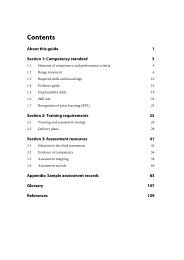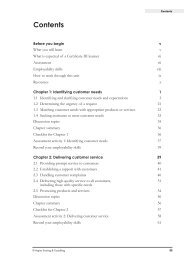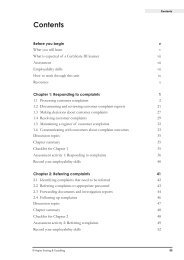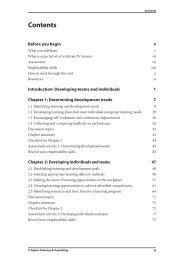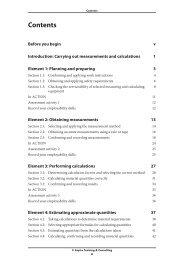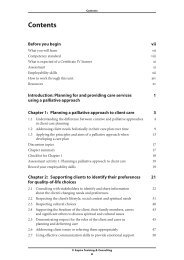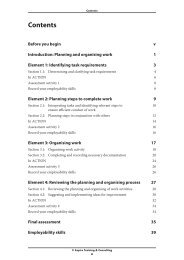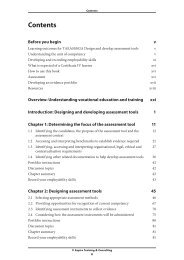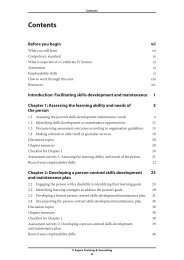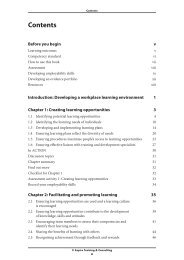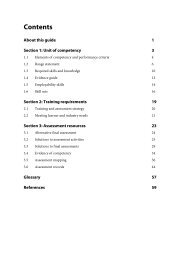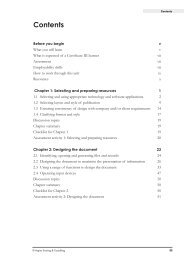view sample - Aspire Learning Resources
view sample - Aspire Learning Resources
view sample - Aspire Learning Resources
You also want an ePaper? Increase the reach of your titles
YUMPU automatically turns print PDFs into web optimized ePapers that Google loves.
Contents<br />
About this guide 1<br />
Section 1: Unit of competency 3<br />
1.1 Elements of competency and performance criteria 4<br />
1.2 Range statement 6<br />
1.3 Required skills and knowledge 9<br />
1.4 Evidence guide 10<br />
1.5 Employability skills 13<br />
1.6 Skill sets 15<br />
1.7 Recognition process 16<br />
Section 2: Training requirements 17<br />
2.1 Training and assessment strategy 18<br />
2.2 Delivery plans 20<br />
Section 3: Assessment resources 27<br />
3.1 Alternative final assessment 28<br />
3.2 Solutions to assessment activities 31<br />
3.3 Solutions to final assessments 40<br />
3.4 Evidence of competency 48<br />
3.5 Assessment mapping 50<br />
3.6 Assessment records 56<br />
Glossary 66<br />
References<br />
Error! Bookmark not defined.
About this guide<br />
This guide is for trainers and assessors of unit BSBITU203A Communicate electronically.<br />
It complements the corresponding <strong>Aspire</strong> learner guide.<br />
As a trainer, you must develop and use training and assessment strategies that embrace<br />
the learner’s needs, educational background, preferred learning style and meet the<br />
requirements of the training package.<br />
This guide provides ideas on how you can encourage and support learners through the<br />
training and assessment process. It is designed to optimise the learner’s experience of<br />
BSBITU203A Communicate electronically and record details of their competency.<br />
The guide is divided into five sections:<br />
Section 1:<br />
Section 2:<br />
Section 3:<br />
Unit of competency<br />
Training requirements<br />
Assessment resources<br />
Glossary (VET sector terminology)<br />
References<br />
How to use <strong>Aspire</strong>’s learner guides<br />
<strong>Aspire</strong>’s learner guides are structured to meet the requirements of the unit of<br />
competency. The learner guide’s preliminary pages include:<br />
information on the unit of competency<br />
learning outcomes required for Certificate II learners<br />
assessment information<br />
employability skills information<br />
additional learning resources.<br />
Each chapter matches an element in the unit of competency. Chapters are in plain English<br />
so they are easy for the learner to understand. The section headings within each chapter<br />
match the performance criteria.<br />
The learner guide content describes procedures and current industry practice and<br />
includes examples, checklists, documents, images and real-life case studies. There are also<br />
illustrations or diagrams to add interest and aid learning.<br />
© <strong>Aspire</strong> Training & Consulting<br />
1
1.2 Range statement<br />
This unit of competency may be relevant to a wide range of workplace contexts. The<br />
range statement relates to the whole unit of competency. It allows for different work<br />
environments and situations that affect performance. Trainers should include other<br />
operating contexts, where appropriate.<br />
The <strong>Aspire</strong> BSBITU203A Communicate electronically learner guide covers all aspects of<br />
the range statement as outlined below.<br />
Software may include:<br />
mobile or wireless software applications:<br />
personal digital assistants (PDA)<br />
mobile phones<br />
text messaging (SMS/TXT)<br />
multimedia messaging (MMS)<br />
internet relay chat (IRC)<br />
personal computer-based software applications:<br />
email applications<br />
web-based email services<br />
chat applications<br />
internet discussion groups/boards/chat rooms<br />
intranet discussion groups/boards/chat rooms.<br />
Organisational requirements may include:<br />
carbon copies or blind carbon copies<br />
concise, relevant subject line<br />
electronic signature<br />
form of address<br />
formality/informality of language, tone and structure<br />
including original message in the reply<br />
length of emails (i.e. short and to the point)<br />
net ethics<br />
© <strong>Aspire</strong> Training & Consulting<br />
6
<strong>Resources</strong> required for assessment include access to:<br />
Access to an actual workplace or simulated environment<br />
Access to office equipment and resources<br />
Access to software applications likely to be used in the workplace.<br />
Methods of assessment<br />
Methods of assessment for this unit of competency may include:<br />
direct questioning combined with re<strong>view</strong> of portfolios of evidence and third party<br />
workplace reports of on-the-job performance by the candidate<br />
analysis of responses to case studies and scenarios<br />
demonstration of techniques<br />
oral or written questioning to assess knowledge of electronic communication methods<br />
and tools<br />
re<strong>view</strong> of attachments prepared for email<br />
re<strong>view</strong> of electronic mailing lists<br />
evaluation of postings and responses to online discussions.<br />
Dimensions of competency<br />
The dimensions of competency relate to all aspects of work performance. The following<br />
table explores the four dimensions of competency in more detail.<br />
Dimensions of competency<br />
What it means<br />
1. Task skills The candidate must perform the individual skills required to<br />
complete a work activity to the required standard.<br />
2. Task management skills The candidate must manage a number of different tasks to<br />
complete a whole work activity such as working to meet<br />
deadlines.<br />
3. Contingency management skills The candidate must use their problem-solving skills to resolve<br />
issues that arise when performing a work activity.<br />
4. Job/role environment skills The candidate must perform effectively in the workplace<br />
when undertaking a work activity by working well with all<br />
stakeholders and following workplace policies and<br />
procedures.<br />
© <strong>Aspire</strong> Training & Consulting<br />
11
1.7 Recognition of prior learning (RPL)<br />
Recognition of prior learning (RPL) is an assessment process that assesses an individual’s<br />
non-formal and informal learning to determine the extent to which that individual has<br />
achieved the required learning outcomes, competency outcomes, or standards for entry<br />
to, and/or partial or total completion of, a qualification.<br />
To have skills and knowledge formally acknowledged, a learner must supply a range of<br />
evidence to verify competency. The trainer then needs to assess this evidence against the<br />
criteria for the qualification.<br />
Evidence of competency may include work <strong>sample</strong>s, journals and third-party<br />
testimonials. Learners may also need to be observed undertaking set tasks and/or answer<br />
set questions.<br />
© <strong>Aspire</strong> Training & Consulting<br />
16
2.2 Delivery plans<br />
The following delivery plans can be used to deliver BSBITU203A Communicate<br />
electronically. These plans, including the time allocations, are suggestions only. You may<br />
need to add to them, change them or substitute your own activities according to the<br />
interest level, experience of the learners and the specific situation. Remember; it is your<br />
responsibility as the trainer to use the most appropriate strategies for your learners.<br />
Topic: Sending and receiving emails<br />
Suggested time allocation: 3 hours<br />
Slide nos: 2–16<br />
Suggested resources:<br />
Recommended reading<br />
Slide presentation software<br />
Email software<br />
Classroom computers<br />
Recommended reading<br />
<strong>Aspire</strong> learner guide BSBITU203A Communicate<br />
electronically<br />
Terminology checklist<br />
Internet Service Provider (ISP)<br />
Chapter 1: Sending and receiving emails<br />
Suggested training strategies<br />
<br />
<br />
<br />
<br />
<br />
<br />
<br />
<br />
Chapter 1 addresses logging into email software, checking outgoing emails, identifying email<br />
characteristics and dealing with returned emails.<br />
Use the introduction to Chapter 1 as a general introduction to this unit.<br />
Section 1.1 addresses logging into email software. The first paragraph explains what equipment is<br />
needed and how this has changed.<br />
Describe OHS best practice when working on a computer.<br />
Guide learners through the learner guide content demonstrating, where relevant, the information<br />
contained. Encourage a class discussion by asking students to describe the methods they use for<br />
sending and receiving emails.<br />
Practice task 2 could be undertaken as a classroom activity with learners working in pairs or small<br />
groups.<br />
Section 1.2 addresses checking outgoing emails. Explain the necessity to take care when drafting and<br />
sending an email, as with any other written correspondence.<br />
Guide learners through the information contained in this chapter, which should include:<br />
- the contents of an email<br />
© <strong>Aspire</strong> Training & Consulting<br />
20
Section 3:<br />
Assessment resources<br />
Assessment is all about collecting evidence and making decisions as to whether or not a<br />
learner has achieved competency. Assessment confirms the learner can perform to the<br />
expected workplace standard, as outlined in the units of competency.<br />
This section contains an alternative final assessment and model answers to the assessment<br />
activities in the corresponding <strong>Aspire</strong> learner guide. The <strong>Aspire</strong> assessment activities have<br />
also been mapped. Trainers and assessors can use this mapping information to complete<br />
the assessment records in section 3.6.<br />
It is an important responsibility of trainers and assessors to complete the assessment<br />
records themselves. This ensures all additional assessment activities deemed appropriate,<br />
outside those in the <strong>Aspire</strong> learner guide, are included in these records; for example,<br />
recording observation assessments.<br />
Section three contains the following information:<br />
3.1 Alternative final assessment<br />
3.2 Solutions to assessment activities<br />
3.3 Solutions to final assessments<br />
3.4 Evidence of competency<br />
3.5 Assessment mapping<br />
3.6 Assessment records<br />
© <strong>Aspire</strong> Training & Consulting<br />
27
3.3 Solutions to final assessments<br />
Final assessment<br />
Part A<br />
Trainers should observe learners demonstrating the required skills and record their<br />
observations in the assessment record provided in section 3.6.<br />
Part B<br />
1. Composing an email.<br />
a) Check that the learner has:<br />
■ used appropriate text in the subject line, such as Workplace health and safety<br />
meeting<br />
■ marked the email as urgent, and possibly included a Read Receipt<br />
■ used clear language<br />
■ included an electronic signature and close<br />
■ ensured they have followed privacy, anti-discrimination and OHS procedures.<br />
The text should be similar to:<br />
Good morning<br />
Next month’s Workplace health and safety meeting will be held in the boardroom<br />
at 2:00 pm on 15 th (insert name of month). All supervisors are required to attend.<br />
Please advise as a matter of urgency whether you will be available to attend.<br />
Regards<br />
(learner’s name – included as an electronic signature. The learner’s position title may be<br />
included in the signature).<br />
The learner may also suggest that if the supervisor is unable to attend as they are<br />
travelling interstate, they may be able to join the meeting using online meeting<br />
software.<br />
b) The learner should include a brief explanation of the action they would take if the<br />
message was returned as undeliverable. This action would be to check the<br />
supervisor’s email address.<br />
© <strong>Aspire</strong> Training & Consulting<br />
40
3.4 Evidence of competency<br />
Evidence is information gathered that provides proof of competency. While evidence<br />
must be sufficient, trainers and assessors must focus on quality evidence rather than the<br />
quantity of evidence.<br />
Rules of evidence<br />
There are four rules of evidence that guide the collection of evidence. Evidence must be:<br />
valid – it must cover the required skills and knowledge<br />
sufficient – it must be enough to satisfy the competency<br />
current – skills and knowledge must be up to date<br />
authentic – it must be the learner’s own work and supporting documents must be<br />
genuine.<br />
Principles of assessment<br />
High quality assessments must be:<br />
■ fair – assessments are not discriminatory or disadvantage the candidate<br />
■ flexible – assessments meet the candidate’s needs and include an appropriate range of<br />
assessment methods<br />
■ valid – assessments assess the unit/s of competency required skills and knowledge<br />
■ reliable – there is a common interpretation of the assessments.<br />
Types of evidence<br />
Types of evidence that can be collected, sighted or validated include:<br />
work records such as position descriptions, performance re<strong>view</strong>s, products developed,<br />
processes followed and/or implemented<br />
third-party reports from customers, managers and/or supervisors<br />
training records and other recognised qualifications<br />
skills and knowledge assessments<br />
volunteer work.<br />
© <strong>Aspire</strong> Training & Consulting<br />
48
Required skills mapped to the learner guide<br />
The following table maps the required skills to the practice tasks and assessment activities<br />
contained in the <strong>Aspire</strong> learner guide.<br />
Required skills<br />
Required skills Practice task Assessment<br />
activity<br />
Final<br />
assessment<br />
Alternative<br />
final<br />
assessment<br />
Communication skills to<br />
request advice, to receive<br />
feedback and to work<br />
with a team<br />
4, 19, 20, 22,<br />
23<br />
Activity 1<br />
Activity 3<br />
Part A<br />
̌<br />
Literacy skills to identify<br />
work requirements; to<br />
understand and process<br />
basic, relevant workplace<br />
information; and to draft<br />
simple correspondence<br />
1, 2, 4, 5, 6, 7,<br />
8, 9, 12, 13,<br />
17, 18, 19, 20,<br />
23<br />
Activity 1<br />
Activity 2<br />
Activity 3<br />
Part A<br />
̌<br />
Problem-solving skills to<br />
solve routine technology<br />
problems<br />
3, 10, 11 Activity 2<br />
Activity 3<br />
Part A<br />
̌<br />
© <strong>Aspire</strong> Training & Consulting<br />
53
3.6 Assessment records<br />
To comply with the critical aspects of assessment and evidence outlined in the unit of<br />
competency, learners must provide evidence of the specified required skills and<br />
knowledge. These should be assessed in the workplace or in a simulated workplace.<br />
Trainers can use the following assessment forms to record the learner’s evidence of<br />
competency.<br />
The pre-assessment checklist helps the trainer determine if the learner is ready for<br />
assessment.<br />
The self-assessment record allows the learner to assess their own abilities against the<br />
requirements of the unit of competency.<br />
The recognition of prior learning inter<strong>view</strong> questions help the trainer match the<br />
learner’s previous training, work or life experience to the requirements of the unit/s of<br />
competency.<br />
The required skills checklist facilitates the observation process; allows trainers to<br />
identify skill gaps and provide useful feedback to learners.<br />
The required knowledge checklist can be used to record the learner’s understanding<br />
of the required knowledge; to identify knowledge gaps and to provide useful feedback<br />
to learners.<br />
The portfolio of evidence checklist helps the trainer annotate or detail aspects of the<br />
learner’s portfolio of evidence.<br />
The workplace assessment checklist can be used by the learner’s supervisor to show<br />
workplace-based evidence of competence.<br />
© <strong>Aspire</strong> Training & Consulting<br />
56
Required skills checklist<br />
Institution:<br />
Candidate’s name:<br />
Unit of competency: BSBITU203A Communicate electronically<br />
Trainer/assessor:<br />
Date:<br />
Did the candidate show they can: Yes No N/A<br />
use communication skills to request advice, to receive feedback<br />
and to work with a team. <br />
use literacy skills to identify work requirements; to understand<br />
and process basic, relevant workplace information; and to<br />
draft simple correspondence.<br />
use problem-solving skills to solve routine technology problems.<br />
<br />
<br />
In the assessment/s of the candidate’s required skills, did they demonstrate the four dimensions<br />
of competency<br />
Task skills<br />
<br />
Task management skills<br />
<br />
Contingency management skills<br />
<br />
Job/role environment skills<br />
<br />
The candidate’s performance was:<br />
Not satisfactory Satisfactory<br />
Feedback to candidate:<br />
Candidate signature:<br />
Assessor signature:<br />
© <strong>Aspire</strong> Training & Consulting<br />
62



